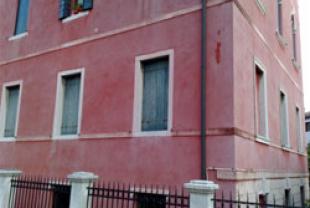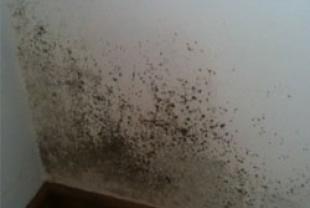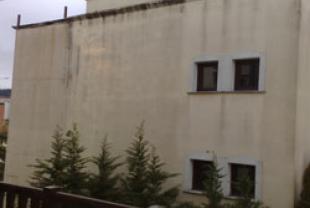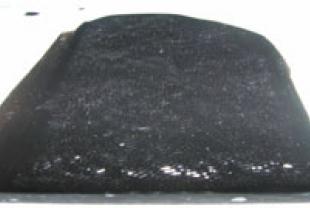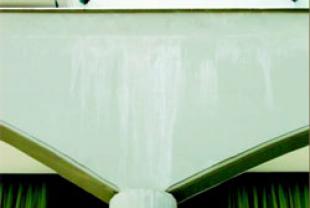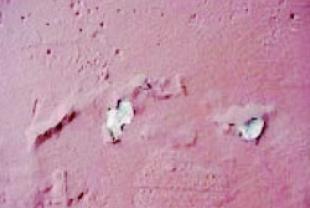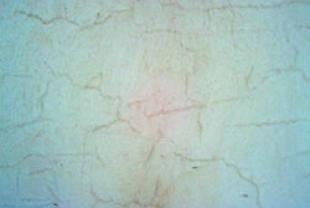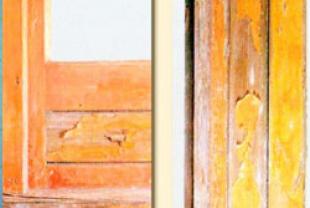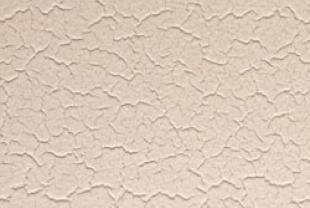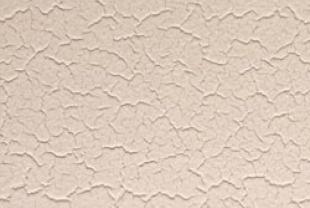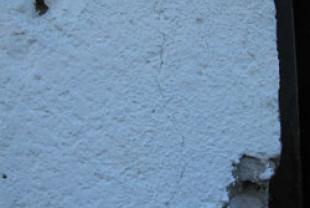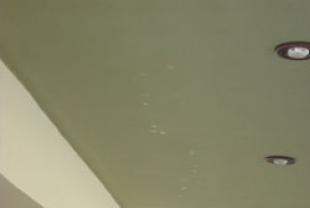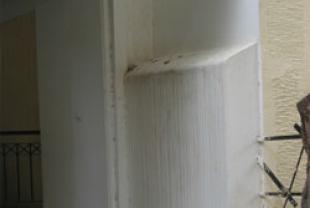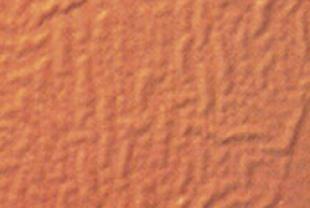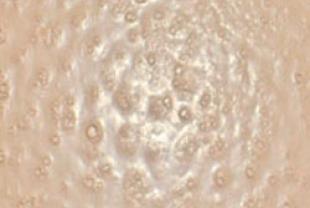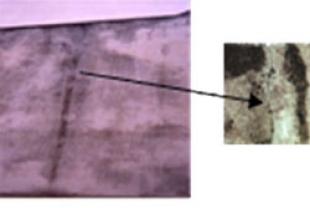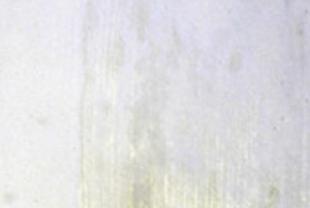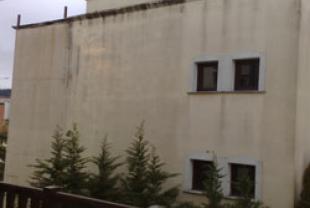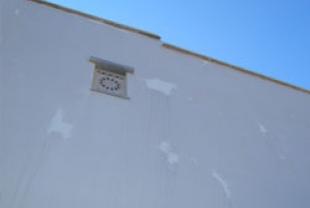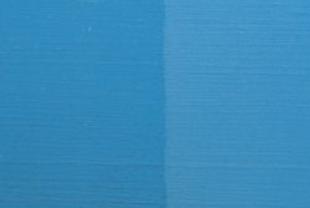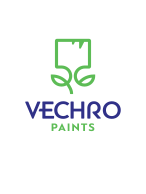
Problems and Solutions
1. The most likely cause of the occurrence is the poor application of the plastering materials in combination with the poor quality and / or composition of the materials used. Previous work (e.g. building, concrete, electrical & plumbing) but also later (e.g. interventions on the final surface such as additions of padlocks, shelters, etc.) of plastering contribute to cracks.
2. Earthquakes, other natural phenomena such as different behavior (contraction / expansion) of materials at points adjacent to a surface (e.g. built parapets & yards, joining beams & columns with masonry bricks, etc.).
3. Accumulated moisture in the plaster, either due to rapid application of paints before the surfaces dry well, or incomplete or non-existent insulation on ceilings, balconies, etc.
4. Large & frequent temperature changes (continuous shrinkage / expansion of materials), and / or painting in periods of very high or low temperatures, and / or application of paints with a low elasticity index.
a) Capillary cracks (<800μm)
Exterior surfaces: Application of elastomeric color Smaltoplast Elastic or Smaltoplast Thermo
Interior Surfaces:
1. If the capillary cracks cover much of the surface, it is recommended to prime with Smaltoplast Universal Primer, then spatulated with Ultra Smaltoplast fix, re-primed with Smaltoplast Universal Primer and painted with Smaltoplast extra or some other Vechro plastic paint.
2. If not, stamping with Ultra Smaltoplast fix or Smaltofill elastic putty where is required, priming with Smaltoplast Universal Primer and painting with Smaltoplast extra or other than the plastic paints of Vechro.
b) Larger cracks (> 800μm)
Exterior surfaces:
1. Opening of the crack and application of elastomeric putty Smaltofill elastic putty
2. Priming with Smaltoplast Universal Primer or Smaltodur and painting with Smaltoplast Elastic or Smaltoplast Thermo
Interior Surfaces:
1. Opening of the crack and application of elastomeric putty Smaltofill elastic putty.
2. Paint with Smaltoplast Extra or other plastic colors
1. High level rates of humidity along with poor ventilation of the area.
2. The water vapor condenses at the masonry points where there is a lack of thermal insulation or thermal bridges.
3. Accumulated moisture in the masonry (problematics pipes, ceilings, gutters, etc) and porous wall surface.
4. Porous wall surface. If the paint of the wall is of low quality matte color, pores are created which can be used by fungi as nests
5. The ingredients of the paint can be food for fungi. However, properly produced color may not be food there is a chance also to kill the fungi. On these surfaces, the mold fungus (black or green) gradually develops
1. To avoid condensation of water vapor internally, it is necessary to improve the thermal insulation of the EXTERNAL masonry, where additionally to the application of external thermal insulation, the energy color of Vechro “Smaltopast Thermo” can be applied alternatively on the exterior surface of the masonry.
2. In the case of accumulated moisture, it is necessary to solve problems in pipes, ceilings, gutters, etc.
3. To repaint the surface a very good cleaning is necessary; the application of fungicidal liquid is required (after the surface is drying). Apply 1 layer of Smaltox Hydro primer and to avoid the reappearance of the mold fungus apply 1-2 layers Smaltoplast Silk (ecological, antimicrobial & hypoallergenic velvet matte plastic color) for preventive and sedative action or Smaltoplast Kitchen & Bath for sedative action.
1. High rates of humidity on the surfaces that the sun cannot reach them (north side of the house).
2. Stable water that is in contact with the wall
3. Porous wall surface. If the paint of the wall is of low quality matte color, pores are created which can be used by fungi as nests.
4. The ingredients of the paint can be food for fungi. However, properly produced color may not be food there is a chance also to kill the fungi. On these surfaces, the mold fungus (black or green) gradually develops
1. Maintenance repairs in pipes, ceilings, gutters or place where the water is stable or there is high level of humidity. There should be the appropriate use of materials.
2. To repaint the surface a very good cleaning is necessary; the application of fungicidal liquid is required (after the surface is drying). Apply 1 layer of primer Smaltox Hydro and 1-2 layers of Smaltoplast Elastic with its antifungal action and Vechro’s energy color "Smaltoplast Thermo"
1. Apply very thick paint
2. Apply layer before the previous one dries
3. Surface drying (not in depth) due to application at high temperature ("soft" color due to its non-hardening).
1. Good surface rubbing (or removal of paint if necessary with Vechro Corrosive Painting)
2. Repaint with Gumilak Metal Duco (with the addition of Gumilak Metal Hardener for better strength and hardness)
1. The salts of plaster, bricks and concrete are transferred to the outer surface of the wall through capillaries, cracks and moisture.
2. Plasters do not have the right composition
3. The wall was primed before the plaster dried well.
4. The wall was not properly primed (e.g. excessive thinning of the primer or use of poor quality primer)
5. The paint used does not have good resistance to the "migration" of salts.
1. The new surface should be primed with Smaltoplast Universal Primer water primer or Smaltodur solvent primer. Then apply 100% acrylic paint Smaltoplast Acrylic or Smaltoplast Silicone or Smaltoplast Elastic, which has increased resistance to "migration" of salts, compared to other acrylic paints!
2. The painted surface should be cleaned of old paints and salts, plastered where needed with ultra Smaltoplast fix, primed and painted with the above recommended paint systems
1. lack of primer and color adhesion.
2. High moisture of the masonry (coming from problematic pipes, ground) and inability of the surface to "breathe" satisfactorily, in order to eliminate water vapor.
3. The humidity of the surface when it was painted was very high.
4. The appropriate primer was not used or the primer was too diluted or the primer did not work properly with the final color.
5. Surface painting at high temperatures (> 35°C)
6. Poor substrate quality (plaster)
1. New surface should be primed with Smaltoplast Universal Primer water primer. Then apply acrylic paint Smaltoplast 100% Acrylic or Smaltoplast Silicone, which has increased adhesion. The Smaltoplast Silicone allows the surface to "breathe" and at the same time waterproof it. The "breathing" primer Smaltoplast Universal Primer ensures the best possible cooperation with the acrylic paints of Vechro.
2. The painted surface should be cleaned of old paint, plastered where needed with ultra Smaltoplast fix, primed and painted with the above recommended paint systems.
1. Poor quality or long-lasting masonry that has not been maintained for years.
2. The plasters do not have the right composition they even apply in a large thickness or in the wrong way.
3. The masonry is exposed to weather conditions with temperature changes or frost conditions.
4. The color used does not have elasticity and good resistance to temperature change.
1. The new surface should be plastered with the elastomeric putty with Smaltofill Elastic Putty beads and primed with Smaltoplast Universal Primer water primer or with Smaltodur soluble primer. Then apply acrylic insulation & paint together Smaltoplast Elastic, which has excellent elasticity, bridges capillaries and micro cracks and offers enhanced anti-mold protection.
2. The painted surface should be cleaned of old paint, plastered with ultra Smaltoplast fix, primed and painted with the above recommended painting systems
1. Poor quality varnish without satisfactory adhesion and elasticity.
2. Multiple layers of old varnishes
3. Wood chips and expansions, as well as pumping - yielding moisture from the wood to the environment, strain the protective varnish.
4. The varnished surface is exposed to weather conditions with large temperature changes.
5. The varnish does not contain the appropriate UV filters to protect the wood from discoloration.
1. The wooden surface should be primed with Smaltoxyl Hydro water preservative and then varnished with Smaltoxyl hydro water varnish. Vechro wood waterproofs product ensures maximum protection in all weather conditions and compared to all solvent varnishes is superior, as it does not peel, it breathes, maintains and repaints easily without the need to remove the previous varnish.
2. The surface should be cleaned of old varnishes with Vechro Corrosive and maintained with the Smaltoxyl Hydro water protection wood.
1. Application of paint in very large thickness (no deep hardening)
2. Application without a good surface cleaning (oil residues, dust, etc.)
3. Surface drying (not in depth) due to application at high temperature ("soft" color due to its non-hardening).
Good surface rubbing (or removal of paint if necessary with Vechro Corrosive paint), repaint with Gumilak Metal Duco (with the addition of Gumilak Metal Hardener for better adhesion, durability) or Smaltolux
1. Apply very thick paint (not proper drying and hardening).
2. Poor quality paints with high content of fillers. In combination with a large application thickness, when the film dries, its cohesion is "lost".
3. Application of paint on top of a solvent primer which did not fully dry. This way the solvents of the primer when heated up, will be trapped between the layers of the primer and the final paint, which results in a "tearing" or "lifting" of the paint layer.
1. Apply very thick paint (not proper drying and hardening).
2. Poor quality paints with high content of fillers. In combination with a large application thickness, when the film dries, its cohesion is "lost".
1. Poor quality paints with a high content of fillers, combined with the use of dyes with low resistance to sunlight).
2. Application on exterior surfaces of plastic paints
3. Large surface exposure to sunlight (mainly on south-facing surfaces)
4. High concentrations of pigments (strong shades, or the addition of additional dyes in order to increase coverage).
5. Surfaces in which the chalking problem occurs along with poor application, such as e.g. turbulent surfaces, large layer thickness (mainly in intense shades), etc.
Repaint with Smaltoplast 100% Acrylic or Smaltoplast elastic. If the fading is intense, first apply Smaltox Hydro Primer
The painting of external surfaces in conditions of increased humidity (such as fog, coolness, frost, etc.) and/or the possible rain in short time after the painting is over, results to delays regarding the color drying. In such cases, it is possible for some of the water-soluble paint components to be trapped as they dry on the surface and appear in places in the form of stains, runs, and glare. Intense shades, as well as application of color in a thick layer combined with the above conditions, are more likely to present the abovementioned problem. Globally that issue is called “snail trail effect”.
It is recommended to rinse the surface with water and lightly rub with a cloth or sponge, as soon as the problem appears. If the problem still exists let it wash over the time. Repainting is not recommended as the problem of the “Runnings” is temporary, it exclusively has to do with the conditions that prevailed shortly after painting and in any case, does not affect durability and longevity of the applied system.
1. Usually vertical surfaces, where the rainwater "licks" on them along with air pollutants (mainly soot, smudges from fireplaces, radiators, grills, etc.).
2. "Hydrophobic - waterproof" surfaces that do not allow rainwater to remove contaminants.
3. Construction failures (e.g. lack of marble flooring).
Good washing of the surface, priming with Smaltox Hydro and apply Smaltoplast 100% Acrylic
1.It usually appears when there is no proper drying e.g. in cases of application of color in large thickness or application of a second layer very soon and before the first dries.
2. Poor drying due to high humidity or high or very low temperatures
3. Apply over a non-abrasive glossy surface.
1. Remove problem areas and other areas with loose paint residue (on old painted surfaces you may need to apply corrosive paint).
2. Glass paper and remove dust.
3. Application of color to the recommended yields and application conditions.
1. All paints (especially water-soluble ones) have a tendency to foam or bubble during application.
2. Excessive stirring of the paint before application
3. Extensive use of roller or brush during application.
4. Use of inappropriate roll.
5. Apply several coats without drying the previous one
6. Apply paint on a very porous surface without priming
1. Remove of the problematic surface, sanding and repairing according to the specifications
2. Selection of products depending on the surface
3. For glossy colors, use a roll with short hair.
4. Do not stir before application
5. Do not use foam rollers on water ripples
The presence of cracking problems for long periods of time may lead to major problems such as disintegration of the plaster, or even corrosion of the concrete reinforcement due to carbonation.
If the problem persists for a long time and the above problems have occurred, it is recommended to get in touch with a qualified technician / engineer in order to estimate the problem and how to deal with it. In any case, intervention must be made with repair materials before priming and painting.
1. Poor surface preparation
2. Paint a masonry surface of high alkalinity which has not mature for at least 30 days (full maturation / drying takes a year).
3. No priming, or applying a suitable primer.
1. New masonry surfaces must be allowed to dry for at least 30 days before painting. This period may be extended depending on the prevailing conditions (high humidity, rain, etc.). The usage of a primer resistant to high alkalinity, e.g. Smaltoplast Universal primer or Smaltodur.
2. On a problematic surface, remove the damaged film and apply Smaltoplast Universal Primer or Smaltodur and then Smaltox hydro.
The repair of cracks, in which apply (by mistake) first the acrylic “mastic” or elastomeric putty and then the transparent primer before the final coloring. Long-term, the mastic plasticizes the paint (i.e. it is more soften in these places) and increases its gloss (by increasing the adhesiveness). At the same time, in this area the color is becoming more waterproof resulting to the lack of rain to wash away the blackness from the air pollutants. It forms droplets that through an imaginary line carrying the back stains. The black stains appear when the surface dries.
To repair the cracks, it is recommended to use the elastomeric putty with Smaltofill elastic putty beads without the need of primer. Due to its composition, the surfaces do not show gloss and black stains
1. The plastered surface has not been primed
2. The paretin used for plastering does not contain any resin or lime
3. The color used is not of high quality (poor in resin) or/and the colorants have been affected by components of the paretin
1. The repairs are stacked with Ultra Smaltoplast Fix or Power Fix for better durability. The usage of reinforcing resin significantly reduces the absorbency of the plastered surfaces and the possibility of a long term “flaking”.
2. After stucco, prime with Universal Primer or Smaltodur with the appropriate dilution.
3. Apply 100% Smaltoplast, Smaltoplast Elastic, Smaltoplast Silicone.
1. When the color is applied with a brush does now has not been dilute more that then one that was applied with a roller
2. There is no good compatibility of pigments with color
Applying color with a brush generally leaves more color on the surface than with a roller. This offers greater coverage fact that results to the abovementioned problem. Hence, you can dilute more the paint that is going to be applied to the corners with brush (e.g. 10% instead of 5-7% with water). We have to apply as thin a color band as possible to the corner.

